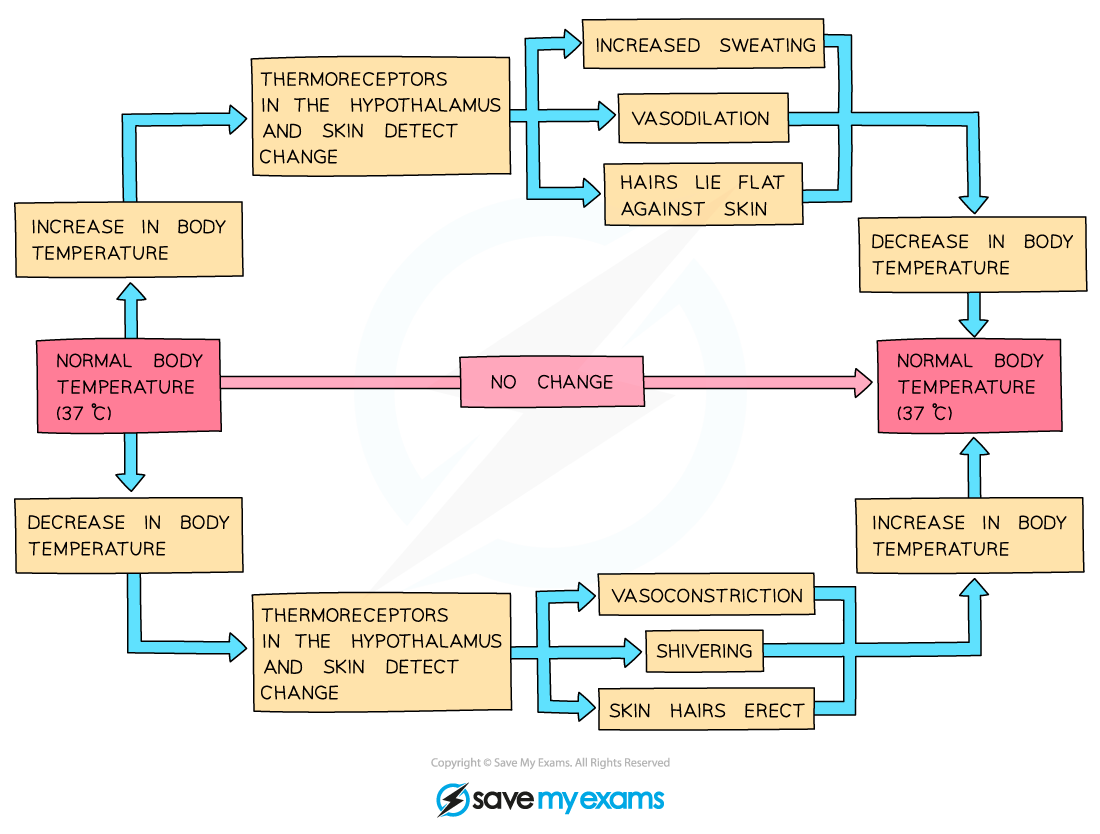The Skin in Temperature Control (OCR GCSE Biology A (Gateway)): Revision Note
Exam code: J247
Thermoregulation
The human body needs to maintain a temperature at which enzymes work best, around 37°C
Processes such as respiration, release energy as heat, while the body loses heat energy to its surroundings – the energy gained and lost must be regulated to maintain a constant core body temperature
Body temperature is monitored and controlled by the thermoregulatory centre in the hypothalamus (structure within the brain)
The thermoregulatory centre contains receptors sensitive to the temperature of the blood
The skin also contains temperature receptors within the epidermal layer which send nerve impulses to the thermoregulatory centre

Human skin contains structures involved in processes that can increase or reduce heat loss to the surroundings. Temperature receptors are located within the epidermis.
If the body temperature is too high, the hair erector muscles relax, blood vessels dilate (vasodilation) and sweat is produced from the sweat glands
These mechanisms cause a transfer of energy from the skin to the environment, cooling the body down

Responses in the skin when the body temperature is too high and needs to decrease
If the body temperature is too low, hair erector muscles contract, blood vessels constrict (vasoconstriction), sweating stops and skeletal muscles contract (shiver)
These mechanisms reduce heat loss to the surroundings (with skeletal muscle contraction increasing heat released in the body)

Responses in the skin when body temperature is too low and needs to increase

Thermoregulation is an example of a negative feedback loop
Vasoconstriction & Vasodilation
Vasodilation
Heat exchange (both during warming and cooling) occurs at the body's surface as this is where the blood comes into closest proximity to the environment
The warmer the environment, the less heat is lost from the blood at the body's surface
One way to increase heat loss is to supply the capillaries in the skin with a greater volume of blood, which then loses heat to the environment via radiation
Arterioles (small vessels that connect arteries to capillaries) have muscles in their walls that can relax or contract to allow more or less blood to flow through them
During vasodilation, these muscles relax, causing the arterioles near the skin to dilate and allowing more blood to flow through capillaries
This can lead to the skin appearing red and flushed when an individual is hot

Vasodilation increases heat loss from the skin
Vasoconstriction
One way to decrease heat loss is to supply the capillaries in the skin with a smaller volume of blood, minimising the loss of heat to the environment via radiation
During vasoconstriction, the muscles in the arteriole walls contract, causing the arterioles near the skin to constrict and allowing less blood to flow through capillaries
Instead, the blood is diverted through shunt vessels, which are further down in the skin and therefore do not lose heat to the environment
Vasoconstriction is not, strictly speaking, a 'warming' mechanism as it does not raise the temperature of the blood but instead reduces heat loss from the blood as it flows through the skin

Vasoconstriction reduces heat loss from the surface of the skin

You've read 0 of your 5 free revision notes this week
Unlock more, it's free!
Did this page help you?